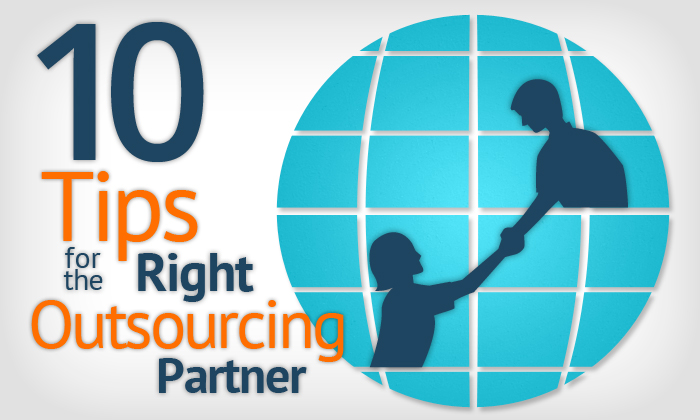10 Tips for Choosing the Right Outsourcing Partner
10 Feb 2014, Posted by in Technologies
If you work in digital media, software development or publishing, chances are you have at least heard about outsourcing, or near sourcing. Both terms are basically the same, though one suggests greater proximity to the US. If you are considering outsourcing some or all of your production or QA work, you will fare better if you engage a provider that truly meets and understands your needs.
Choose someone who understands the value of planning
As someone with experience both as a client and a vendor I have learned how to optimize the outsourcing experience. Here are some important guidelines derived from my experience.
- Assess Your Needs – Before you engage an outsource partner evaluate your current capacity and future needs. If you are supplementing an in-house team, assess their strengths and weaknesses. Factor in the growth you are anticipating (future head count) and make a list of all key knowledge or skills you need to retain locally to be agile and successful. Perhaps your company’s unique value rests in its editorial and art staff and it makes sense to outsource engineering. Or, conversely maybe your company’s success is based on its engineering prowess, in which case art and editorial might be more appropriate for outsourcing. If you do not have an in-house team, make a forecast of the possible in-house resources you may need to complete your task. At a minimum you will need someone to manage the outsource relationship, communicate your company values, and have the authority to approve or reject deliverables. Ideally, if you intend to build a series of products that have ongoing importance to your company, you should consider putting a technical person and a project manager in place. These people can not only manage and shepherd the process, they can insure that key product knowledge is always available locally and if you need to make a change in providers, you are not left out in the cold.
- Define Your Project Requirements as Best You Can – It is often difficult to plan your project requirements before you have a partner in place to help you. However, at a minimum you should know what kind of product you want, what market it will have to compete in, what its approximate price point will be and how many units you will need to make a good rate of return. Have a budget in mind, if at all possible. If necessary, work backwards from your business model. Make sure your budget fits your potential market and pricing. Identify when you would like to launch your product into the market. This information will be essential in discussing the project with potential partners. A good partner will tell you if your expectations are unreasonable and can help you modify them accordingly. (If you don’t like what you hear, you can always go elsewhere though beware of the one provider in four who says it can be done when the others all say it can’t.) If there are any similar products already on the market that can give your prospective partner an idea of the style and scale of your project, make sure to let the partner know. That will help the partner understand the scope of your vision and be better able to give you a reasonable projection. Finally, if your product is a web product or mobile app, remember to consider items like tracking, registration, multiple language versions, and community features, etc. These variables add time and cost to projects and should be at least contemplated from the start.
- Check References – Be sure to check provider references. Too many clients have been burned by providers who did not deliver what they promise. Clients end up with half-done projects and ¾ spent budgets. The last thing you want is to be seeking a patchwork solution which may not work and you cannot afford.
- Choose a provider that knows your market – Ideally, find a provider who has experience in your particular area of service or market. Such a provider will have already “learned” the parameters of your market and will not have to learn on your dime.
- Be time-zone friendly – Find a provider in a time zone that is reasonably compatible with your own. Communication across multiple time zones can be inconvenient and slow at best. At worst, it can cause missed deadlines and frayed tempers. Be wary of companies that promise to work all night to match your hours. This might work for small projects but for projects of any scale, you will most likely have an exhausted and minimally productive team.
- Interview outsourcers as you would interview any new employee – When interviewing prospective Outsourcers, draw from your own experience hiring employees. Ask the same kinds of questions of your Outsourcer. Does the Outsourcer have the skills, attitude and commitment you want on your team? Does the Outsourcer share your work ethic, subscribe to your business values, and have a reputation for honesty and transparency?
- Evaluate communication skills – Key to outsourcing success. Good communication is absolutely essential to the success of an outsourced project. When you talk to prospective outsourcing partners, assess the ability of their management teams to understand your needs and communicate effectively with you and your people. Not all outsourced team members need to speak English, but those with whom you have contact should be fluent speakers who are capable of accurately communicating your needs to the development or QA team.
- It’s not just about price – It’s hard to resist the temptation to go with the rock-bottom bidder and sometimes that bidder is indeed the best. However, an extra 5%-15% savings has no value if your product is substandard. Make sure the quality of your vendor’s work meets your market’s needs.
- Choose someone who understands the value of planning – A good provider will insist that you begin your work together by planning it out carefully. If you and your vendor are on the same page with respect to product design and expectations, your production phase will proceed more smoothly. Many good providers will even suggest that you engage them first for a planning stage. While often clients resist this, experience shows that a planning stage can save valuable time and money later.
- Choose a partner with a US presence – While most outsourcing experiences are positive, you cannot ignore the possibility that you and your partner may someday have a disagreement. For this reason it is prudent to choose an outsourcer that is a legal US entity or incorporated in the US. In the event of a problem or dispute, you want to be able to work it out with someone in your own country, governed under US laws.
TAGS > ANDROID, CMS, IOS, LMS, NEARSOURCING, OUTSOURCING, SOFTWARE DEVELOPMENT
NO COMMENT




